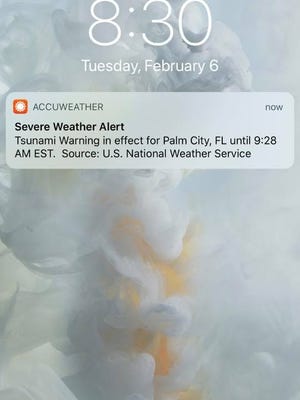Tsunami warning for East Coast? Just a false alarm, NWS says
 Gray Hughes
Gray Hughes
Some Delmarva residents received an AccuWeather notification of a tsunami warning Tuesday morning that may have spoiled breakfast.
But there is no threat for the East Coast, according to the National Weather Service.
The weather service is looking into a possible glitch that sent a tsunami warning from the Accuweather app at about 8:30 a.m. to residents from Florida all the way up north to the New England area.
"There was an app that may have inadvertently sent it out in error," said Matt Scalora, a meteorologist with the National Weather Service in Wakefield, Virginia. "We do tsunami alert testing every month, and it was the same message that went out every month."
It wasn't until 30 minutes after the initial alert was sent that the AccuWeather agency sent a tweet saying it was a test. The National Weather Service also made sure to alert its Twitter followers that the message was sent erroneously.
"It's not routine, it's not part of the test," said Lance Frank, a meteorologist with the National Weather Service in Mount Holly, New Jersey. "Some users have gotten warnings, and that is not the case. When the tsunami test is conducted, it should not go out as an outlook, watch, warning or advisory. So this is not normal."
Frank said he would refer people to tsunami.gov for further information, and right now there is no threat for a tsunami anywhere on the coast.
A search of the tsunami.gov website at 9:45 a.m. showed there were no tsunami warnings, advisories, watches or threats in the United States.
According to a statement from Maureen O'Leary, of the National Oceanic and Atmospheric Administration, the National Tsunami Warning Center, the National Weather Service issued a routine test message this morning.
"The test message was released by at least one private sector company as an official Tsunami Warning, resulting in reports of tsunami warnings received via phones and other media across the East Coast, Gulf of Mexico and the Caribbean," she said. "The test message was not disseminated to the public via any communication channels operated by the National Weather Service."
The National Weather Service is looking into why the test message was distributed by private sector companies, she said.
They will provide more information once it is available, she added.

More recently, an authentic tsunami warning was triggered for coastal Alaska after a magnitude-7.9 earthquake pulsed under the Gulf of Alaska. A tsunami was generated by the quake, but no damage or deaths were attributed to it.
Tsunamis are long, tall tidal waves usually associated with earthquakes. They can be among nature's most lethal phenomena. A 2004 tsunami killed more than 227,000 people in Sumatra, Indonesia and India.
The tsunami alert glitch occurred just weeks after an alert was sent to Hawaii warning of a ballistic missile attack on the island.
The message, sent in error, read "Ballistic Missile Threat Inbound To Hawaii. Seek Immediate Shelter. This Is Not A Drill."
Thirty-eight minutes later, Richard Rapozza, Hawaii Emergency Management Agency public information officer, said the message was sent in error.
The head of the Hawaii Emergency Management Agency resigned, and the officers who sent the false alert was fired, but not before the message caused residents to seek cover, hide in basements and reach out to family and loved ones out of fear the alert was real.
READ MORE: Ocean City council votes to reject 'visible' offshore wind farm
READ MORE: Rural Delmarva may get $1.3B natural gas pipeline
Information from USA Today and Treasure Coast News was used in this report.
This report will be updated.
On Twitter @hughesg19